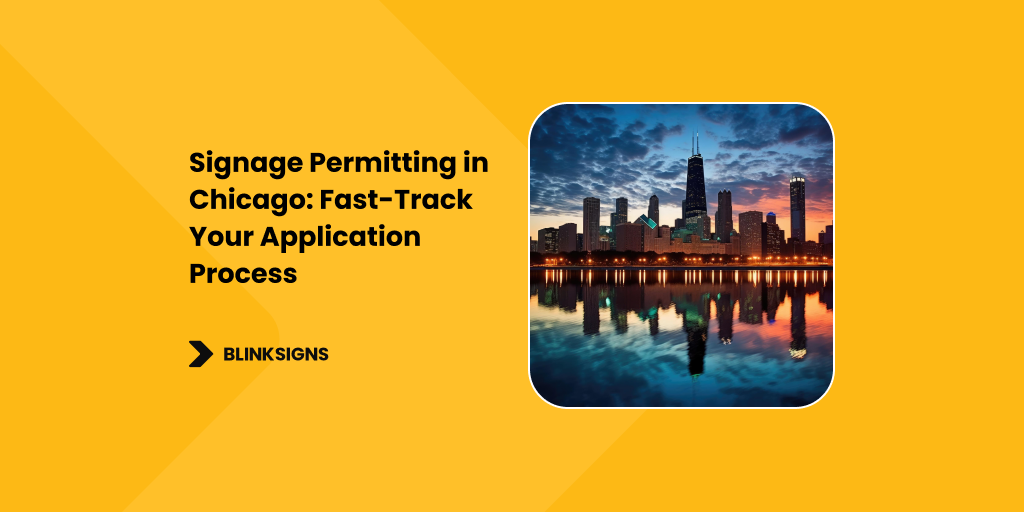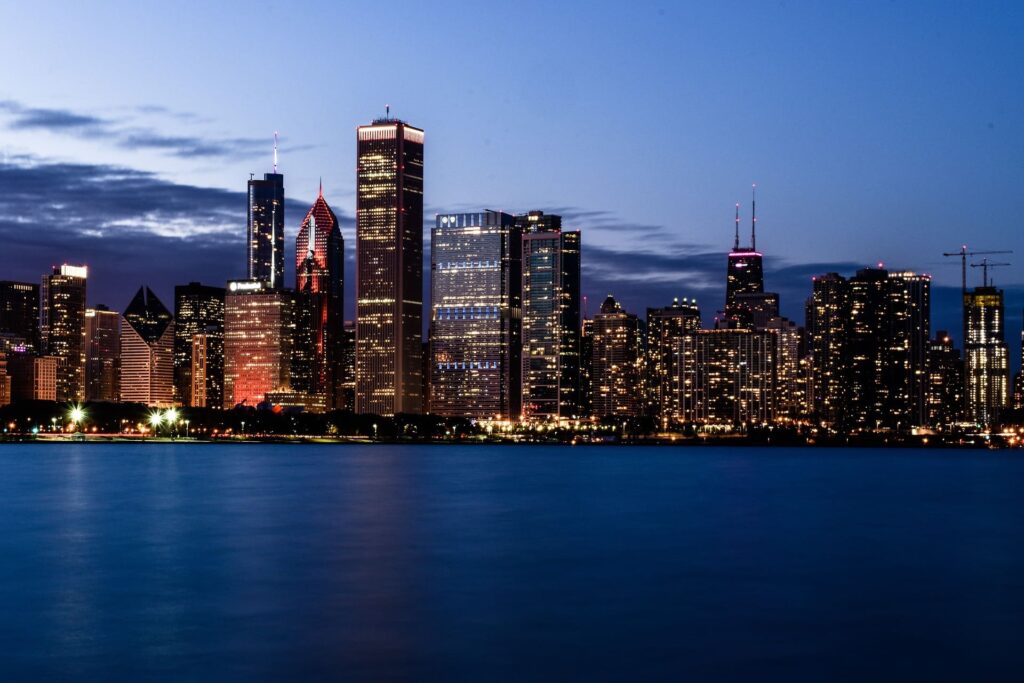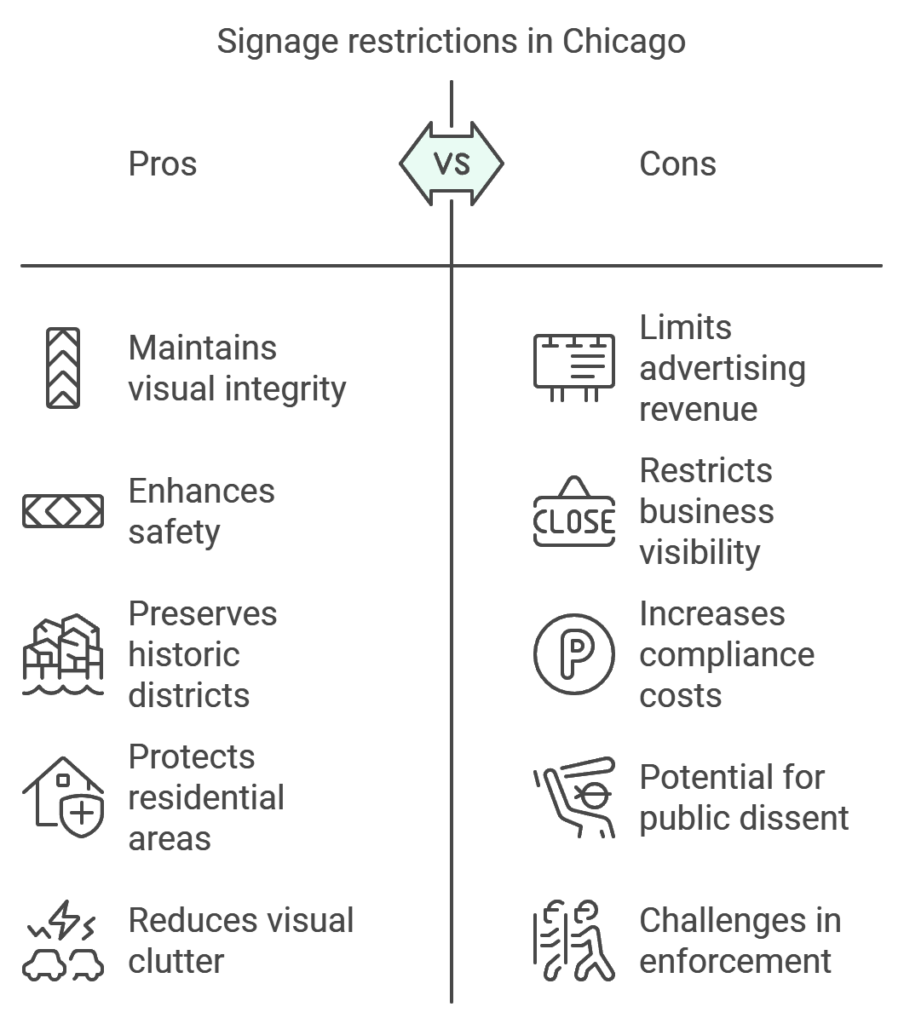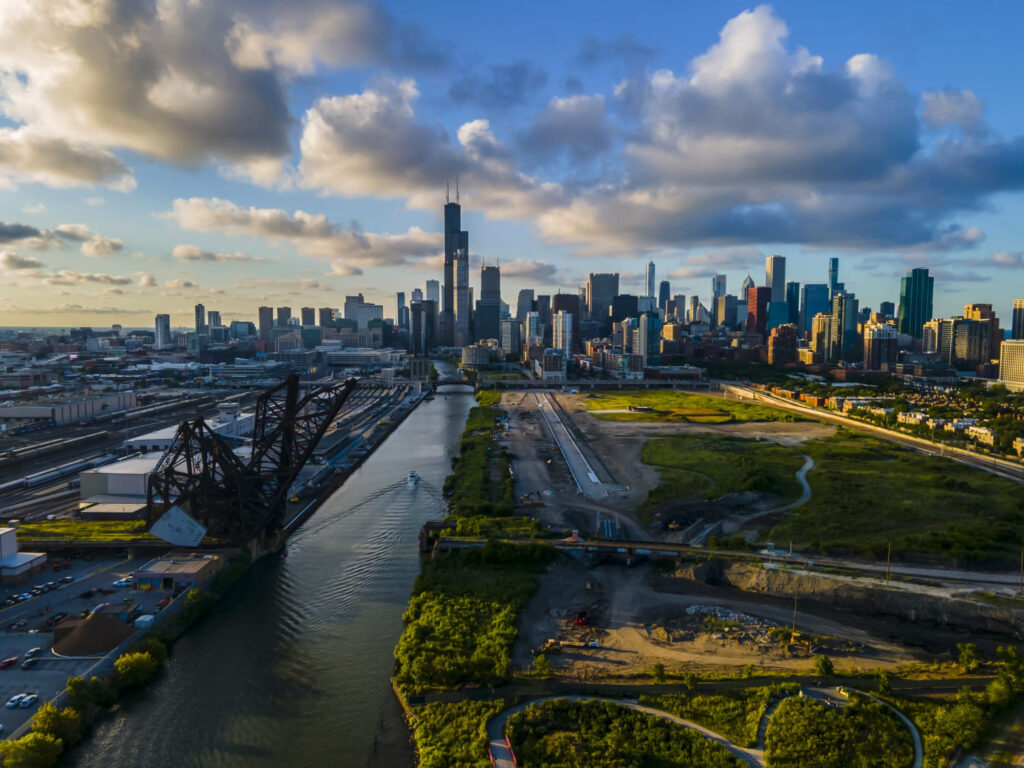
Signage Permitting in Chicago: Fast-Track Your Application Process
Signage in Chicago serves a dual purpose for businesses: it not only boosts visibility and attracts customers but also contributes to the city’s unique visual and architectural landscape. In a city as diverse as Chicago, signage is critical in creating a brand presence, guiding customers, and enhancing neighborhood aesthetics. The city’s regulatory framework requires businesses to follow specific signage permitting processes to ensure that each sign aligns with structural safety standards, visual harmony, and community values.
BlinkSigns supports businesses through this process of Signage Permitting in Chicago, helping clients navigate the requirements smoothly to achieve compliant, impactful signage.

Chicago Skyline
Understanding Sign Permits and Key Regulatory Authorities
What is a Sign Permit?
A sign permit is an official authorization that confirms signage compliance with local and state regulations. This permit process helps ensure that each sign is safely and legally placed, serving its intended purpose without posing risks to public safety or violating aesthetic norms. Requirements vary depending on the signage type, such as Freestanding Signs, Wall Signs, or Digital Billboards, as well as the sign’s height, setback, and visibility factors. Sign permits involve submitting detailed applications, which include specifications on sign area, materials, and illumination levels to demonstrate compliance with Chicago’s safety and zoning codes.
Primary Regulatory Authorities in Chicago
- Chicago Department of Buildings: The Department is responsible for reviewing and approving signage permits, confirming compliance with structural safety and placement regulations, and assessing applications based on zoning laws and design standards.
- Zoning Board of Appeals: The Zoning Board addresses cases requiring variances from standard zoning restrictions. Businesses needing signage that exceeds height, placement, or illumination restrictions must present their cases to the Zoning Board, where additional reviews and appeals may apply.
- Illinois Department of Transportation (IDOT): IDOT regulates all signage along state-managed highways and roads. It enforces standards focused on driver safety, mandating specific height, setback, and illumination controls to prevent distractions or block sightlines.
Legal Framework for Sign Regulation
Chicago’s signage regulations are rooted in the Municipal Code and zoning ordinances, which provide a comprehensive framework governing all sign types. These codes outline requirements for Sign Area, height limits, and structural integrity, ensuring that signage enhances Chicago’s neighborhoods rather than detracting from their aesthetic appeal. IDOT guidelines further govern signs near highways, emphasizing traffic safety and unobstructed views. Compliance with these regulations is essential for businesses to avoid penalties, fines, or enforced signage removal, preserving safety and local character.

Signage Regulations Chicago
Types of Signage and Their Specific Requirements
On-Premise vs. Off-Premise Signs
- On-Premise Signs: Located on the business property, these signs advertise products, services, or the business itself. Examples include Wall Signs, Awning Signs, and Monument Signs. Zoning regulations address sign area, height, setback, and design to ensure compatibility with the surrounding neighborhood.
- Off-Premise Signs: Typically, billboards or digital billboards, these signs promote off-site businesses or events and face stringent regulations. IDOT regulates these signs, focusing on spacing, illumination, and height requirements to prevent driver distractions and uphold safety along state roads and highways.
Common Sign Types and Compliance Standards
| Type of Signage | Description | Compliance Requirements | Typical Usage |
| Wall Signs | Signs mounted directly on a building’s exterior wall | Size and height restrictions apply; must adhere to building setbacks and zoning codes | Branding for businesses, store names |
| Monument Signs | Freestanding signs placed at eye level, often at property entrances | Structural integrity requirements must follow setback limitations and height guidelines | Business parks, schools, hospitals |
| Pylon Signs | Tall, freestanding signs are often used to attract visibility from highways. | Height limits based on proximity to roads and residential zones must meet wind load standards. | Shopping centers, gas stations |
| Digital and Electronic Message Centers (EMCs) | Signs with digital displays that can change messages | Brightness and animation frequency controls are restricted in certain residential and historic districts | Retail promotions, hotels, stadiums |
| Awning Signs | Signs incorporated into building awnings, typically over entrances | Size and projection limitations; must maintain pedestrian clearance and adhere to color/material guidelines in historic areas | Restaurants, retail stores |
| Projecting Signs | Signs that extend outward from the building, perpendicular to the wall | Projection limits for pedestrian safety: must maintain a specific clearance above ground level | Bars, theatres, boutique shops |
| Temporary Signs | Non-permanent signs such as banners, A-frames, or construction signs | Time restrictions; specific placement guidelines; often requires a temporary permit | Real estate listings, event promotions |
| Billboards | Large, off-premise signs, often located near highways or high-traffic areas. | IDOT spacing, height, and lighting regulations; prohibited in certain scenic or protected zones | High-visibility advertising |
| Directional and Wayfinding Signs | Signs that guide pedestrians and vehicles to specific locations within a property | Size and visibility standards: must not obstruct traffic views or pedestrian pathways | Parking lots, malls, hospitals |
| Window Signs | Signs placed inside or on windows, visible to passersby | Limited to a percentage of window space; additional restrictions in some districts to prevent excessive visual clutter | Sales promotions, store hours |
| Feather Flags and Banners | Temporary fabric signs that are often used to promote sales or events | Time limits and placement restrictions may require anchoring to avoid obstructions during windy conditions | Sales events, outdoor festivals |
| Canopy Signs | Signs affixed to or hanging from canopies over entrances or walkways | Height and clearance requirements: must meet wind resistance standards if extending over public walkways | Hotels, theatres, shopping centres |
| Roof Signs | Signs placed on top of a building’s roof, often visible from a distance | Zoning restrictions in residential and historic districts; height and structural standards for safety | Large-scale branding, urban areas |
| Directional Traffic Signs | Signs designed to manage traffic flow within a property or parking area | Must comply with visibility, legibility, and placement standards for public safety | Parking lots, drive-thru restaurants |
| Historic District Signs | Signs within designated historic areas that require specific aesthetic considerations | Must be approved by the Chicago Landmarks Commission; typically requires materials and colors that match historic district standards | Museums, heritage buildings, historic hotels |
Prohibited Sign Types in Chicago
Certain signage types, including flashing signs, oversized digital billboards, and animated displays, are prohibited from maintaining the visual integrity and safety of Chicago’s roads and neighborhoods. These restrictions apply mainly along scenic byways, residential areas, and historic districts, where aesthetic and environmental considerations are paramount.

Signage restrictions in Chicago
Step-by-Step Guide to the Chicago Sign Permitting Process
- Application Preparation and Submission
Successful permit applications begin with a comprehensive set of documents, including site plans, elevation drawings, and—if illuminated—electrical permits. Key details, such as sign area, height, setback, and material composition, must align with city regulations to streamline approval. Accurate and complete submissions minimize delays in the review process.
- Plan Review and Approval Process
Following submission, the Chicago Department of Buildings conducts an extensive review to ensure compliance with structural and zoning standards. Digital signs, EMCs, and illuminated signs may require additional scrutiny to meet brightness, placement, and design guidelines. Timelines for approval vary depending on sign complexity, with some applications taking longer due to district-specific reviews, especially in neighborhoods with strict aesthetic codes.
- Inspection Requirements and Compliance Checks
Approved applications proceed to an inspection phase, where structural, electrical, and zoning compliance is verified. This process covers wind load ratings, visibility standards, and illumination levels, ensuring all components meet safety and compliance standards. Periodic inspections may follow to confirm continued adherence to local codes.
- Permit Issuance and Installation Guidelines
Once all requirements are met, a permit is issued, authorizing the business to install the signage. Installation must comply with height, setback, and illumination guidelines to prevent future compliance issues. Regular maintenance is recommended to preserve the sign’s structure and appearance, ensuring it remains an asset to the business and community.
Chicago Neighborhood-Specific Signage Requirements

City of Chicago
- Loop District
The Loop District, Chicago’s business core, enforces regulations controlling sign density, placement, and illumination to prevent visual congestion. Illuminated signs in this area must adhere to specific brightness standards to reduce light pollution while preserving the professional aesthetic of the business hub.
- River North and Magnificent Mile
Tourist-heavy districts like River North and the Magnificent Mile require signage that aligns with high-end aesthetic standards. Businesses must follow design guidelines encouraging artistic and creative signage styles, incorporating quality materials that enhance the area’s appeal.
- South Loop and Streeterville
Digital signage regulations in South Loop and Streeterville balance the needs of commercial and residential zones. Signs must adhere to brightness limits, size restrictions, and operational hours to prevent disruptions in residential zones while supporting commercial visibility.
- Historic Districts
Chicago’s historic neighborhoods have strict signage regulations to preserve their architectural character. Signs must meet material, color, and design requirements that prevent disruption to the historical ambiance and promote harmony with existing building styles.
ADA and Accessibility Standards for Signage in Chicago
ADA Compliance Requirements
ADA regulations require that Chicago’s signage include accessible design features, such as Braille, raised text, and high-contrast finishes. These standards ensure that public signage remains accessible to individuals with visual and physical disabilities, supporting inclusivity throughout the city.
Visibility and Readability Standards
Chicago enforces ADA readability standards that mandate specific character sizes, font styles, and placement for accessibility. Signage in high-traffic areas must meet readability requirements to ensure easy navigation and compliance with city regulations.
Inspections for Accessibility Compliance
Routine inspections confirm signs meet ADA standards, emphasizing non-glare finishes and clear visibility. Non-compliance can lead to penalties, so businesses must maintain ADA-compliant signage to support all community members.
Permitting Fees and Additional Costs in Chicago
Permit Fees by Sign Type and Location
Sign permitting fees in Chicago are influenced by sign type, zoning designation, and location. For instance, costs for digital billboards and EMCs are higher due to their technical complexity and potential impact on public areas.
Additional Costs and Financial Requirements
Other costs include permit fees, bond requirements, inspection fees, and periodic renewal fees. Businesses must budget for these expenses as part of their signage investment to avoid financial surprises and maintain regulatory compliance.
Cost Overview for Major Chicago Areas
In high-traffic areas like the Loop or River North, permitting fees tend to be higher due to zoning considerations and the demand for premium visibility. Businesses in these areas should anticipate higher costs and longer review periods.
Compliance with IDOT Regulations for Highway and Scenic Signage
Highway Signage Requirements
IDOT mandates specific signage guidelines for areas along state-managed highways, prioritizing driver safety and visibility. Height restrictions, setback limits, and illumination levels ensure that signage does not obstruct or distract from the road.
Scenic Byways and Protected Zones
Signs near Chicago’s scenic byways must adhere to design and placement restrictions to preserve natural beauty. High-impact designs are discouraged to avoid interference with the visual experience of these zones.
Prohibited Signs Along State Highways
IDOT restricts flashing, animated, oversized signs along state highways to prevent driver distractions. Compliance with these guidelines is essential to maintain safety and avoid penalties or enforced removal.
Variance and Appeal Processes for Chicago Sign Permits
When a Variance is Necessary
A variance allows businesses to obtain approval for signage that might not fully comply with Chicago’s standard regulations. Variances are typically sought when signs exceed height limits, setback requirements, or brightness standards. This flexibility is especially relevant for businesses in dense urban zoning or within specific districts like the Magnificent Mile, where unique signage needs may arise. Variances support businesses by providing a pathway for customized signage that enhances visibility and suits business goals, all while maintaining safety and design standards.
Applying for a Variance
Applying for a variance in Chicago involves a detailed process that includes submitting an application, providing a rationale, and demonstrating how the sign will still meet public safety and aesthetic standards. Documentation typically required includes detailed plans, site specifications, and an impact assessment. Businesses are encouraged to justify why the variance is necessary, such as unique building configurations or the need to stand out in a high-density area. Approval timelines may vary, and some cases require an appearance before the Zoning Board of Appeals, which reviews applications and determines the impact on the community.
Appeal Process for Permit Denials
Businesses can appeal through the Zoning Board of Appeals when a signage permit is denied. The appeal process requires submitting a formal request and outlining reasons for the appeal. It often includes additional documentation to address concerns raised in the initial denial. Working with professionals like BlinkSigns can help ensure all materials meet Chicago’s standards, enhancing the chances of a successful appeal. Appeals allow businesses to make a case for signage that supports visibility and community standards.
Maintenance and Renewal Requirements for Chicago Sign Permits
Routine Maintenance Standards
Signage maintenance in Chicago is essential to ensure continued compliance with safety, visibility, and aesthetic regulations. Illuminated and digital signs, especially outdoors, require regular upkeep to maintain brightness levels, structural integrity, and functionality. Cleaning, inspecting for weather damage, and repairing electrical components are necessary to keep signage compliant. Checking wind load resilience and structural issues is vital for freestanding, monument, and pylon signs. Routine maintenance extends the sign’s life and keeps it safe and effective for long-term use.
Permit Renewal Processes
Permit renewal is mandatory for certain signs, mainly temporary and illuminated ones. Renewal timelines vary based on sign type and district regulations; for example, temporary signs like banners and A-frames may require renewal every few months, while permanent signs may have more extended intervals. The renewal process typically involves submitting an application that includes updated documentation on the sign’s condition, location, and recent maintenance activities. Ensuring that signs meet current compliance standards is critical, as non-compliance can result in fines, additional inspections, or removal orders.
Recordkeeping for Compliance
Chicago businesses must maintain detailed records of all permit applications, renewals, inspections, and maintenance activities. Accurate documentation helps streamline the renewal process and provides a compliance history, which can be valuable during inspections or audits. Businesses are encouraged to log all maintenance activities and keep records of repairs and inspections, especially for illuminated and prominent signage. Staying organized with documentation also assists in efficiently managing budget allocations for signage upkeep.
Environmental and Aesthetic Standards for Chicago Signage
Light Pollution and Noise Standards
Light pollution is a growing concern in urban settings, and Chicago enforces regulations to minimize light spillage, especially near residential zones. Illuminated signage, such as LED and Digital Billboards, must comply with brightness restrictions to reduce light pollution and support the city’s environmental goals. Noise standards also apply to ensure interactive or digital signs prevent disturbances, particularly in mixed-use areas or near residential neighborhoods. These standards ensure that signage enhances the environment without detracting from the quality of life for residents.
Eco-Friendly Materials and Sustainable Practices
Chicago encourages using eco-friendly materials for signage to support sustainable practices and reduce environmental impact. Recyclable materials, energy-efficient LED lighting, and non-toxic finishes are recommended, especially in neighborhoods with green initiatives or eco-friendly zoning requirements. Opting for sustainable materials benefits the environment and aligns with the city’s broader goals for reducing carbon footprints and supporting long-term energy conservation. BlinkSigns offers options that allow businesses to meet these eco-friendly requirements while maintaining durability and aesthetic appeal.
Aesthetic Guidelines in Historic and Scenic Areas
In Chicago’s historic and scenic districts, signage must conform to aesthetic guidelines that preserve architectural heritage and cultural character. Materials, colors, and designs should be carefully selected to blend with the existing architecture, particularly in neighborhoods like the Loop and River North, which emphasize traditional or artistic signage styles. Design review boards may require approval for signs in these areas to ensure they reflect the community’s historical or cultural identity. Compliance with these standards is crucial for businesses that maintain a positive relationship with the community and enhance the neighborhood’s overall appeal.
Tax and Financial Considerations for Signage in Chicago
Tax Implications for Permanent Signs
In Chicago, permanent signage such as pylons, monuments, and billboards may be subject to property taxes, as they are considered part of the property’s overall value. Businesses should plan for these tax obligations when budgeting for signage, as tax assessments can vary based on sign type, size, and location. Understanding these tax requirements helps businesses manage their finances more effectively and avoid unexpected costs.
Deductible Expenses for Businesses
Certain costs associated with signage, such as maintenance fees, permitting fees, and renewal costs, may qualify as tax-deductible expenses. These deductions can help businesses reduce tax liability and allocate more funds toward other operational expenses. Consulting with a tax professional is advised to maximize eligible deductions while ensuring compliance with state and federal tax regulations.
Investment Strategies for Compliant Signage
Investing in high-quality, compliant signage is a strategic decision that can enhance brand visibility while supporting long-term financial savings. Businesses are encouraged to choose durable materials and energy-efficient lighting to reduce maintenance costs and ensure longevity. Strategic placement in high-traffic areas while adhering to zoning restrictions can maximize the return on investment by attracting more foot traffic and enhancing brand recognition. BlinkSigns provides expert guidance on selecting materials and designs that balance cost-effectiveness with visual impact.
Special Considerations for Historic and Protected Areas in Chicago
Historic District Compliance
Chicago’s historic districts are subject to special regulations to protect their unique architectural and cultural heritage. Businesses in these areas must adhere to guidelines restricting certain materials, colors, and design elements to maintain the district’s traditional look and feel. Signs must reflect the neighborhood’s architectural style, with restrictions on modern features like LED lighting or overly vibrant colors. Compliance with these requirements helps businesses align with the community’s values and enhance the area’s historical charm.
Environmental and Protected Zones
Signage must meet additional standards to protect the local ecosystem and scenic views in environmentally sensitive areas, such as parks, preserves, and scenic zones. Chicago enforces strict setback and height limitations to prevent obstructions in natural areas, with certain areas prohibiting illuminated or digital signage altogether. These regulations aim to reduce environmental impact and preserve the natural beauty of protected zones, creating an inviting environment for both residents and visitors.
Architectural Review Board Guidelines
The Architectural Review Board oversees signage design standards in Chicago’s protected and historic areas to ensure aesthetic consistency. This board reviews applications for signs in these districts, evaluating design aspects like the color scheme, material choice, and overall harmony with the local architecture. Approval from the board is typically required before installing signage, making it essential for businesses to align their designs with the board’s criteria to avoid delays or rejections.
FAQs about Signage Permitting in Chicago
How can BlinkSigns help with the entire signage permitting process in Chicago?
BlinkSigns guides you from initial consultation to final installation, handling paperwork, code compliance, and zoning requirements to streamline Chicago’s complex permitting process.
Are there special considerations for digital or illuminated signage in Chicago?
Yes, Chicago enforces brightness, animation limits, and operating hours for digital signs, especially in residential and historic areas. BlinkSigns ensures your signage adheres to these standards.
What documentation is needed to apply for a sign permit in Chicago?
A complete permit application requires site plans, elevation drawings, sign height and material specs, and electrical details for illuminated signs. BlinkSigns manages all necessary documentation for you.
Does BlinkSigns assist with variances if my sign doesn’t meet Chicago’s standard codes?
Absolutely. Our team supports variance applications for unique signage needs, providing documentation and guidance to help secure approval from the Chicago Zoning Board of Appeals.
How does BlinkSigns ensure compliance with ADA standards for signage?
BlinkSigns offers ADA-compliant designs with Braille, accessible font sizes, non-glare finishes, and strategically placed signs to meet accessibility standards in public spaces.
Are there additional steps for signage in Chicago’s historical districts?
Signs in Chicago’s historic districts require design approval to meet specific aesthetic guidelines. BlinkSigns designs signage that preserves historic charm while ensuring compliance.
What are the main costs involved in obtaining a sign permit in Chicago?
Permit fees vary by location, sign type, and additional requirements, such as electrical inspections. BlinkSigns provides a precise estimate to help with the budget for permitting and installation.
Can BlinkSigns assist with the ongoing maintenance and renewal of permits in Chicago?
BlinkSigns offers maintenance and compliance checks for durability and renewal timelines, helping businesses update their signage with city regulations.
Are there restrictions on using eco-friendly materials for signage in Chicago?
Chicago encourages sustainable signage solutions, especially in environmentally sensitive areas. BlinkSigns specializes in eco-friendly materials that meet both aesthetic and compliance needs.
What types of signs typically don’t require permits in Chicago?
Some small, non-illuminated signs or temporary promotional displays may not require permits. BlinkSigns can assess your signage needs to determine when permitting is necessary.
Conclusion: Navigating Chicago’s Signage Permitting Process with Confidence
Securing a sign permit in Chicago requires adherence to a detailed set of regulations, but the rewards for compliance are significant. Through thoughtful design, careful planning, and alignment with the city’s codes, businesses can create impactful signage that enhances brand recognition and customer experience. The city’s regulatory framework balances visibility, aesthetic appeal, and safety, helping companies to thrive while contributing positively to the community.
BlinkSigns offers comprehensive support to Chicago businesses, from initial consultation to the final inspection, ensuring a smooth permitting process that meets all requirements. Our team’s design, compliance, and project management expertise helps businesses achieve stand-out signage while staying within regulatory guidelines.
Investing in compliant signage with BlinkSigns is an investment in your brand’s visibility and role within the Chicago community. It creates a lasting impression that resonates with customers and residents alike.